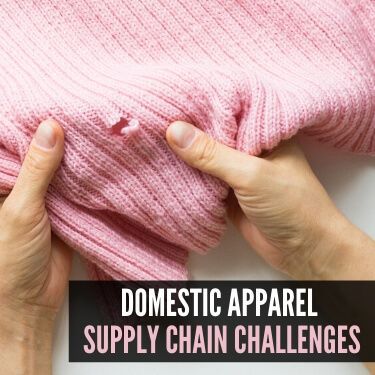Apparel supply chains are worldwide and this means that the level of operation that goes into them can sometimes be complex. Working in such a large scale industry can be a challenge for some fashion brands, and reducing labor costs and shipping costs is an important factor in their success. The apparel industry continues to grow and thrive every single year and is set to drive global retail markets.
North Carolina is a hub for fabric and apparel manufacturing. The typical process of the apparel supply chain is the procurement of raw materials, followed by production and manufacture of clothing. Once garments have been finalized, they can be transported to companies across the world to be distributed to relevant parties and customers. Bridging the logistical issues is something that expert apparel shipping companies can do.
North Carolina is one of the leading textiles and apparel suppliers in the United States and in the world. This state is known for its work in the apparel industry and its high contribution to the value of the industry both domestically and worldwide. In 2017, there were almost $2 billion worth of apparel and textile exports just from North Carolina, and it leads the apparel value for the whole of the United States.
There are over 600 specialized apparel facilities in North Carolina, all employing experts in their field to produce high quality items. The Wilson College of Textiles in North Carolina State University is recognised for its research into textiles and has managed to breed the next generation of textile experts.
The supply chain process for apparel can be simply broken down into a few steps:
The supply chain for clothing is more complex than this, and due to its global reach the logistics behind packaging and shipping apparel can be a big challenge.

North Carolina is quite rightly a world leader in the textiles industry. As a state, they hold a fundamental role in the U.S. economy for their work in apparel. North Carolina is a textile machine and provides jobs for thousands of people every year. They have a very long history in the textile world, and since 1810 have been producing cloth sold domestically to a value of $2 billion.
The textiles industry has been dropping in recent years globally and in the U.S., however North Carolina continues to grow and thrive every single year. This powerhouse of apparel is one that is crucial to the world.
North Carolina is a powerhouse when it comes to producing textiles, and once the state has produced items they can be exported to other states and other countries around the world. To put North Carolina’s influence into context, in 2012 the US exported a value of $17.7 billion in textile and apparel products. Of this figure, North Carolina was responsible for $2.3 billion, making them worth 13% of the U.S. market.
To transport apparel safely, it needs to be packaged tightly and in a waterproof bag or pouch. Fabric is sensitive to both moisture and clothes moths, so using sealable plastic bags is the best method to ensure safe transit of this type of product.
North Carolina's export industry is growing by the day and using safe methods of export is a key way to ensure they can thrive for years to come.
Need cross-country freight shipping from North Carolina to California? See how a strategic partner can get your apparel from factory to L.A. runway.

Due to the sheer scale and the complexity of the apparel supply chain it is important for apparel shippers to overcome issues and challenges with ease. There are many different challenges that can be faced by apparel companies during the shipping process and all of these needs to be managed efficiently to avoid problems later down the line.
Here are some common challenges faced in the supply chain for apparel:
High industry demand makes it imperative for the apparel industry to cope with a myriad of issues. Before you think about shipping your own apparel for your brand you need to learn how to work around these common issues and make your supply chain as smooth as possible for success.
Any logistics company who specialises in apparel knows how difficult the process can be and the challenges that may be faced. This is why R+L Global Logistics is a great choice to work with when you start out in the business. Don’t let complex supply chain and logistics issues weigh you down and overwhelm you. Allow an expert team to manage shipments at every stage of production from raw materials to export to customer.
If you are just delving into the apparel industry and need a shipping company you can trust, choose us and we will ensure your products are safe from start to finish. We handle everything from apparel to transporting eggplants. We’re here to help you learn more about shipping freight from North Carolina. Give us a call at (866) 353-7178 or request a freight quote online.
The supply chain process for apparel can be simply broken down into a few steps:
Apparel is designed by fashion designers
Apparel is produced in factories all over the world
Apparel is cut, sewn, woven, and embellished to create a final product
Apparel is packaged and shipped to distributors worldwide
The apparel makes it to the consumer
Here are some common challenges faced in the supply chain for apparel:
Overseas delays: If manufacturing is taking place overseas such as in China, this can cause delays in terms of shipping and meeting launch deadlines
Lost or damaged: Shipping overseas is a huge challenge and if moisture gets into the boxes it could cause mould to grow. Or if the boxes become crump-led or ripped there is a risk of damaged items.
International holidays: If apparel orders are not placed in advance of key holidays this can delay the transit of items
Increased tariffs overseas: If another country increases entry fees for freight ships and trucks this can be a roadblock for smaller brands
Supply issues with raw materials: When supply and demand are perfectly balanced you have a happy business. However, sometimes demand many override supply and this can be a big issue for those producing apparel
To transport apparel safely, it needs to be packaged tightly and in a waterproof bag or pouch. Fabric is sensitive to both moisture and clothes moths, so using sealable plastic bags is the best method to ensure safe transit of this type of product.
It is important to allocate a clean and dry space for folding clothes ahead of transport to avoid dirt, dust, and moisture
Clothing should be wrapped in tissue paper and placed into sealable plastic bags for security
Boxes should be packed as much as possible and taped securely.
The supply chain process for apparel can be simply broken down into a few steps:
Apparel is designed by fashion designers
Apparel is produced in factories all over the world
Apparel is cut, sewn, woven, and embellished to create a final product
Apparel is packaged and shipped to distributors worldwide
The apparel makes it to the consumer
R+L Global Logistics
315 NE 14th St., Ocala, FL 34470